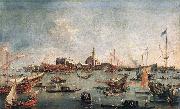Wholesale Oil Painting No Minimum |
|||||||||||
|
|
|||||||||||

|
|||||||||||
|
|
|
||||||||
GUARDI, FrancescoItalian Rococo Era Painter, 1712-ca.1793 The records of his parish in Venice show that Francesco Guardi was baptized on Oct. 5, 1712. His father, Domenico, who died when Francesco was 4, had a workshop. Francesco and his elder brother, Gian Antonio, worked in a small studio, carrying out such orders as they could get for almost anything the client wanted:mythological pictures, genre, flower pieces, battle scenes, altarpieces, and even, on rare occasions, frescoes. They did not hesitate to copy compositions by other artists, but what they borrowed they always transformed into something more capricious, less stable, more fragmentary in the refraction of light. Francesco did not emerge as an independent personality until 1760, when his brother died. Then, 48 years old, he married, established his own studio, and devoted himself chiefly to painting views of Venice. For the most part he worked in obscurity, ignored by his contemporaries. He was not even admitted to the Venetian Academy until he was 72 years old. Guardi and Canaletto have always been compared to one another because the buildings they chose to paint were often the same. But the way each artist painted them is very different. Canaletto's world is constructed out of line. It provides solid, carefully drawn, three-dimensional objects that exist within logically constructed three-dimensional space. Guardi's world is constructed out of color and light. The objects in it become weightless in the light's shimmer and dissolve in a welter of brushstrokes; the space, like the forms in space, is suggested rather than described. Canaletto belonged essentially to the Renaissance tradition that began with Giotto and, as it grew progressively tighter and more controlled, pointed the way to neoclassicism. Guardi belonged to the new baroque tradition that grew out of the late style of Titian and, as it became progressively looser and freer, pointed the way toward impressionism. Such differences appear even in Guardi's early view paintings, where he was obviously trying to copy Canaletto, such as the Basin of San Marco. The famous buildings are there, but they are far in the background, insubstantial, seeming to float. In front is a fleet of fishing boats, their curving spars seeming to dance across the surface of the canvas. What is important for Guardi is not perspective but the changing clouds and the way the light falls on the lagoon. Guardi became increasingly fascinated by the water that surrounds Venice. In late works, such as the famous Lagoon with Gondola, buildings and people have been stripped away until there is nothing but the suggestion of a thin line of distant wharfs, a few strokes to indicate one man on a gondola, a long unbroken stretch of still water, and a cloudless sky. Guardi also painted the festivals that so delighted visitors to the city, such as the Marriage of Venice to the Sea. This was a symbolic ceremony in which the doge, in the great gilded galley of the head of state, surrounded by a thousand gondolas, appeared before all Venice, in Goethe's image, "raised up like the Host in a monstrance." Of all Guardi's paintings the most evocative are his caprices, the landscapes born out of his imagination though suggested by the ruined buildings on the lonely islands of the Venetian lagoon. A gentle melancholy clings to such scenes. |
||||||||
|
|
||||||||
The Doge on the Bucentaur at San Niccol del Lido
The Doge on the Bucentaur at San Niccol del Lido Painting ID:: 63058 |
1766-70 Oil on canvas, 67 x 100 cm Musee du Louvre, Paris This painting belongs to a series of twelve canvases, almost all in the Louvre, which recount the various episodes in the election of Doge Alvise Mocenigo of Venice in 1763. In reporting this event Guardi was inspired by engravings after the other master of the Venetian veduta (view), Antonio Canaletto. An observant and picturesque record of the traditional Venetian festival, which was part official ceremony and part popular rejoicing, this series attests to the pictorial verve of Guardi and to his sensitivity to the most fleeting atmospheric effects, worthy of the Impressionists over a century later. Artist: GUARDI, Francesco Painting Title: The Doge on the Bucentaur at San Niccol?del Lido , 1751-1800 Painting Style: Italian , , landscape 1766-70 Oil on canvas, 67 x 100 cm Musee du Louvre, Paris This painting belongs to a series of twelve canvases, almost all in the Louvre, which recount the various episodes in the election of Doge Alvise Mocenigo of Venice in 1763. In reporting this event Guardi was inspired by engravings after the other master of the Venetian veduta (view), Antonio Canaletto. An observant and picturesque record of the traditional Venetian festival, which was part official ceremony and part popular rejoicing, this series attests to the pictorial verve of Guardi and to his sensitivity to the most fleeting atmospheric effects, worthy of the Impressionists over a century later. Artist: GUARDI, Francesco Painting Title: The Doge on the Bucentaur at San Niccol?del Lido , 1751-1800 Painting Style: Italian , , landscape |
|||||||
|
CONTACT US |

